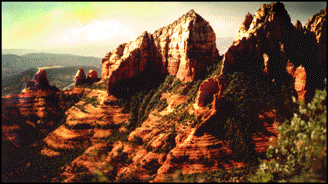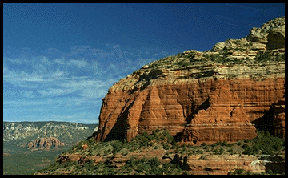December 1, 1995
Throwing a boomerang in Sedona, Ariz. can be a tricky endeavor. Sedona is one of the West’s most mystical places, long noted for its spiritual energy and vortexes.  Sedona’s scenery is breathtaking, with red-rock canyons, magical buttes and ancient spires majestically dotting the landscape like Zen transmitters and receivers, bouncing primordial voltage into the rarefied atmosphere. If ever there was a place to launch a spiritual sail, or a boomerang (in this case, a Dharma Boom), Sedona is the place.
Sedona’s scenery is breathtaking, with red-rock canyons, magical buttes and ancient spires majestically dotting the landscape like Zen transmitters and receivers, bouncing primordial voltage into the rarefied atmosphere. If ever there was a place to launch a spiritual sail, or a boomerang (in this case, a Dharma Boom), Sedona is the place.
About halfway up the trail to Mount Wilson, just to the north of Sedona, a level plateau seemed the perfect place to launch the boom. Gripping the boom tightly and pausing once to take in the geologic spectacle, I launched the boom. About 30 feet in the air, it somersaulted gracefully, reaching its apogee. Suddenly, a distant mechanical sound bounced off the Oak Creek Canyon walls to the east, shattering the silence. The boom fell to the ground into the branches of a large juniper bush. The sound quickly became recognizable as it drew nearer. No, it wasn’t an ancient Hohokam shaman flying her magic carpet to whisk me to the ancient realms. Much to my chagrin, it was a single-prop airplane, one of many I would hear during my stay in Sedona. The plane, along with the fleets of helicopters that scour the airspace, carried touristas, giving them a bird’s-eye view of Sedona. For me, however, the overflights pierced the veil of Sedona’s energy and revealed a darker force in this special place.
I’ll attribute the boom’s doomed flight to my lack of throwing technique rather than to the noxious overflight. But as Sedona becomes more and more attractive a destination, the citizens are faced with a challenge: To retain its charm and natural beauty without sacrificing its soul to tourism and development. That is, if it’s not too late.
The road to Sedona from Flagstaff, U.S. 89A, winds through the lush Coconino National Forest along scenic Oak Creek Canyon. Huge sycamore trees provide a broadleaf canopy creekside. Several U.S. Forest Service campsites are available along the creek. As one nears Sedona, exquisite rock formations rise out of the forest as if to signal the change in landscape – from high-altitude forest to red-rock canyon country. The city itself sits at 4,300 feet and is divided into the older, art-gallery, tourist-oriented part of town, and the sprawling subdivisions of West Sedona.
Numerous hiking trails traverse the surrounding landscapes, each yielding unforgettable views of canyons, pinnacles and buttes. The Mount Wilson Trail begins at Midgley Bridge, about two miles north of town on U.S. 89A. Rising quickly from the bridge, the trail switchbacks to the plateau mentioned above, First Bench, then up the summit to nearly 7,000 feet. The views along the way are spectacular (above). Mount Wilson is named for Richard Wilson, a bear hunter who perished at the hands of a grizzly in 1885. Allow nearly a full day for the hike to the summit and bring along plenty of water.
To the northwest, the Devil’s Bridge Trail is an easy trek offering glimpses, across a wide valley, into the geologic treasures of the Red Rock/Secret Mountain Wilderness (below). This trail leads to a sweeping natural bridge called Devil’s Bridge or Rainbow Bridge. The earth is this area is powdery red and the temperatures can be 10-15 degrees warmer than in Oak Creek Canyon.
There is no doubt Sedona is feeling growing pains. In 1960, about 4,000 people lived in Sedona. Today, the city of more than 15,000 people hosts between five and eight million visitors, according to the U.S. Forest Service, which is “constantly” working to alleviate stress on local trails. Sedona’s peak tourist season is basically from April to November, but locals point out it’s now difficult to distinguish between peak and off-peak. “We’ve about had enough,” said one weary local. Such sentiments were perhaps best expressed by a bumper sticker – “Keep Sedona Beautiful – When You Leave, Take Someone With You.” Even into late October, campsites along Oak Creek and all hotel rooms were full to capacity. In West Sedona, real estate rules, with “Real Estate Central” perched prominently on a hillside. Even Kokopelli, the long-haired ancient Hopi flute player, said to have lured Native American cliff-dwellers out of their caves with his music, has been enlisted in the real estate scramble. His now almost ubiquitous image appears at the entrance to a new townhome community.
It’s not only the scenery and temperate climate that draws people here. Sedona is said to possess many “power centers” or vortexes, concentrations of magnetic and/or electrical energy. Most of the vortexes are geologic formations. According to author Nicholas R. Mann, a suitable vortex or “cone of power” is “essentially the blending of all the elements in a harmonious energetic form which could then be dispersed for healing on a local or planetary scale or for other purposes.” (“Sedona – Sacred Earth,” Zivah Publishers, Prescott, Ariz.) Mann’s geomantic (“divination of place”) interpretation of Sedona is enchanting, combining ancient myth, geology and map interpretation to drive home the point that Sedona is indeed teeming with freaky energy. Ironically, Mann writes, “The key to activation of such [power] centers is sound. At the appropriate time and season certain sounds resonating with the rock will induce a spiral of energy to rise in the manner of a snake gathering itself in a coil in order to lift up its head and hiss.” Ah, the sounds of Sedona. Which brings us back to airplanes and helicopters.
 With airports both in Sedona and Flagstaff, and with plans to construct up to 45 hangars at the Sedona Airport, overflights appear to be here to stay. A Forest Service volunteer pointed out that the agency doesn’t control the airspace over its lands, including designated wilderness areas which are intended to preserve an element of solitude. While he said the community is constantly questioning the appropriateness of the flights, the flip side is that the flights lets folks “go in and go out” without leaving a trace. Or, without breaking a sweat or getting their new Kokopelli T-shirts dirty. Sitting above Devil’s Bridge, taking in the bewitching scene, solitude will last about 20 minutes, when the next dive-bombing tourist express destroys any notion that one is removed from the trappings of civilization and commerce.
With airports both in Sedona and Flagstaff, and with plans to construct up to 45 hangars at the Sedona Airport, overflights appear to be here to stay. A Forest Service volunteer pointed out that the agency doesn’t control the airspace over its lands, including designated wilderness areas which are intended to preserve an element of solitude. While he said the community is constantly questioning the appropriateness of the flights, the flip side is that the flights lets folks “go in and go out” without leaving a trace. Or, without breaking a sweat or getting their new Kokopelli T-shirts dirty. Sitting above Devil’s Bridge, taking in the bewitching scene, solitude will last about 20 minutes, when the next dive-bombing tourist express destroys any notion that one is removed from the trappings of civilization and commerce.
Recalling Mann’s comment about sound resonating with rock to induce energy, one wonders if the ancient ones don’t have something in mind in Sedona. How many overflights, with chopper and single-prop sounds bouncing off sacred mesas, will the primordial rock take before crumbling? Or will Kokopelli return to play a vengeful tune?
David Iler